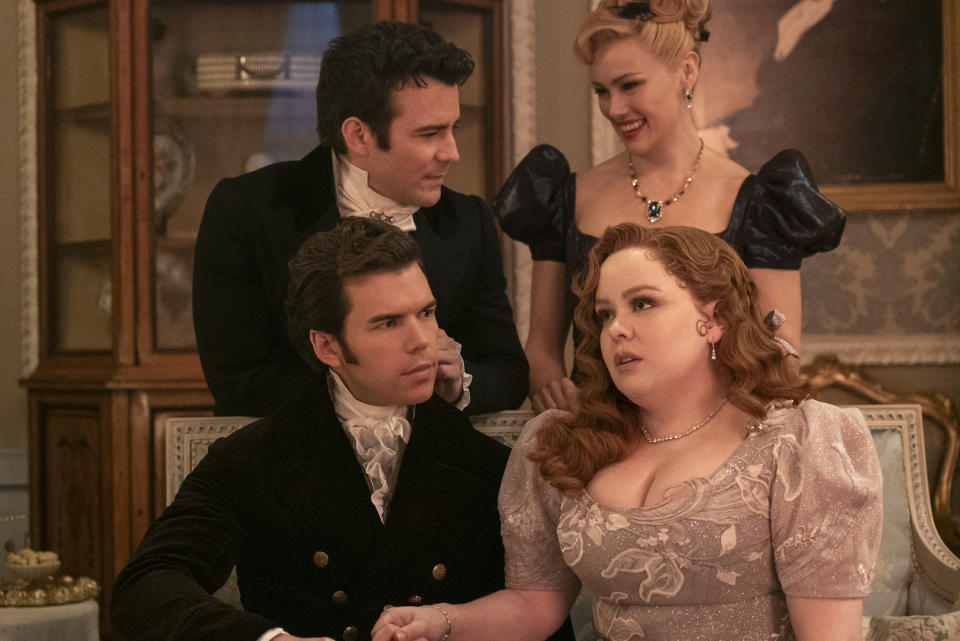Sex scenes on film may appear seamless, but behind the camera, they’re meticulously crafted by intimacy coordinators aiming to reshape Hollywood’s approach to the work.
Once a fledgling role, intimacy coordinators have become a normalized part of filmmaking since the rise of the #MeToo movement in 2017. Jessica Steinrock, CEO of Intimate Directors and Coordinators training organization, said the profession has grown exponentially in recent years.
“When I first started out, there was no precedent,” Steinrock told Yahoo Entertainment. “The only folks hiring us were those ahead of the game or deeply committed to actor safety. If you’re doing a scene involving nudity or simulated sex, having an intimacy coordinator is just a given now.”
Advertisement
Advertisement
That shift was solidified by SAG-AFTRA’s 2023 contract rules, which require producers to “use best efforts” to hire intimacy coordinators for scenes involving nudity or simulated sex. The union recently took another step by unanimously voting to unionize intimacy coordinators.
Next year, the profession will reach another milestone with the first-ever Intimacy Professional Summit, a conference uniting directors, producers and coordinators to establish industry standards.
But despite its growing acceptance, Steinrock said the field is still evolving.
“We’re still in the early phases of this work,” she said. “It’s no longer the wild, wild West of intimacy work. We’ve emerged as a profession, but there’s still room for growth and fluctuation.”
The mechanics of intimacy coordinators
Lizzy Talbot, the intimacy coordinator for Babygirl and Bridgerton, said the need for these professionals became clear during her early work onstage, where there was “no common established terminology” for handling intimate scenes.
Advertisement
Advertisement
“Actors were often having to draw directly from their personal lives,” she told Yahoo Entertainment. “The damage was often mental and emotional but more importantly — invisible.”
Contrary to popular misconceptions, Steinrock said intimacy coordinators are not directors or creative collaborators. Their role is to provide “mechanical support” and “movement facilitation” to bring the director’s vision to life. That often involves choreographing movements, ensuring safety barriers are in place and working closely with costume teams.
“We’re there to support the director’s vision within the boundaries of the actors,” Steinrock explained. “The relationship between the director and the actor is sacred, and one that I personally hold very dearly, as do many of my colleagues.”
Clockwise from top left: “Bridgerton” stars Luke Thompson as Benedict Bridgerton, Hannah New as Lady Tilley Arnold, Nicola Coughlan as Penelope Featherington and Luke Newton as Colin Bridgerton. (Liam Daniel/Netflix)
Talbot approaches intimate scenes with a similar mindset, focusing on choreography as a storytelling tool. Scenes involving orgasms, often considered taboo, are treated no differently.
Advertisement
Advertisement
More in Entertainment
“I approach them like any other choreographic moment,” Talbot said. “An actor may have a specific process for this, which I don’t want to inhibit, but I’ll always offer tools such as movement, breath work and vocals if an actor asks.”
Steinrock echoed the importance of flexibility and compassion when filming such vulnerable scenes.
“It depends on how the actor wants to work,” she said. “Some actors want to stay in the moment and do take after take, while others might say, ‘I’ll do one take and need a five-minute break.’ It’s about giving actors the tools they need to feel agency and autonomy in their creative work.”
Boundaries and consent are top priorities, especially in sensitive scenes that call for arousal.
Advertisement
Advertisement
“With performances of orgasm and arousal, there can be a sense that the actor’s performance is just true to how they express pleasure in their real life, which is not what we want, as that’s very exposing for them,” Robbie Taylor Hunt, the intimacy coordinator for LGBTQ projects like Red, White & Royal Blue and Mary & George, told Yahoo Entertainment.
To address this, Hunt said these scenes require “specific discussions” with the actor and director about how sexual responses align with the character.
Missionary sex became a hot-button topic, thanks to a steamy sex scene in the 2023 gay rom-com “Red, White & Royal Blue.” (Prime Video)
On a broader scale, Hunt noted that intimacy coordinators can even provide unexpected sex education by challenging misconceptions, ensuring performances are authentic rather than based on “tropes or stereotypes.” A sex scene in Red, White & Royal Blue, for example, earned praise from viewers who had previously believed it wasn’t possible for two gay men to have missionary sex.
“An IC is there to offer suggestions about how to create the queer sex scene in a way that feels realistic and beyond basic expectations,” Hunt said. “Through this, we can help to avoid creating something that evokes poor reactions from the queer community on release, and instead have the scenes celebrated.”
Stories from the set
Recent films like Miller’s Girl, Babygirl and It Ends With Us have underscored the importance of intimacy coordinators.
Advertisement
Advertisement
Nicole Kidman, who worked with Talbot on Babygirl, praised the protective atmosphere created by the production team while filming a series of masturbation scenes.
“There was enormous caretaking by all of us,” Kidman said at a press conference in August. “It felt very authentic, protective and, at the same time, real.”
Justin Baldoni, director and star of It Ends With Us, also credited intimacy coordinators with elevating the film.
“It was so important to have them on set — not just so that we could all feel safe, but because they were also incredible collaborators with wonderful ideas that really elevated the film,” Baldoni told Harper’s Bazaar India.
Advertisement
Advertisement
Those sentiments were echoed by Baldoni’s co-star, Blake Lively, who told Digital Spy that “being choreographed is critical for everyone’s safety” in sex scenes in the film.
Justin Baldoni and Blake Lively in a scene from “It Ends With Us.” (Nicole Rivelli/Sony Pictures Releasing/Courtesy of the Everett Collection)
For Ewan McGregor, who worked with a coordinator on A Gentleman in Moscow, the role provides safeguards against power imbalances.
“If an older, famous director goes to a 22-year-old and says, ‘I want you to be naked in this scene,’ that actress might feel, ‘Oh, my God, I’ve got to do it,’” McGregor told Radio Times. “Five years after that, she could look back and go, ‘I wish I hadn’t. Why am I naked in that scene? It’s unnecessary.’”
Emphasizing that intimacy coordinators benefit everyone on set, McGregor added, “It’s still necessary because it’s also about the crew. … It’s an important part of the work now, because it’s somebody that the director and actors meet in the middle.”
More than safety
Talbot emphasized that her role goes beyond ensuring actors’ physical safety, likening it to how a stunt coordinator provides specialized tools for complex scenes.
Advertisement
Advertisement
“We deal with a massive range of subject matter — from miscarriage to sexual violence — that can affect not only the performers but also those working closely around them,” she explained. “Sharing expert knowledge of how intimate scenes function helps every department, and the entire production runs more smoothly.”
Steinrock sees the profession as essential for fostering trust.
“Intimate scenes involve a high level of vulnerability, and actors deserve specialized support during these moments,” she said. “Our role is to ensure boundaries are protected and actors are able to do their best work.”
Added Steinrock, “Intimacy coordination isn’t just about safety — it’s about better storytelling.”
EMEA Tribune is not involved in this news article, it is taken from our partners and or from the News Agencies. Copyright and Credit go to the News Agencies, email news@emeatribune.com Follow our WhatsApp verified Channel




